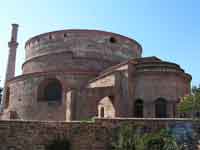|
|
The Arch of Galerius (Greek: τόξο του Γαλερίου or Aψίδα του Γαλερίου) and the Tomb of Galerius (Τάφος του Γαλερίου) are neighbouring monuments in the city of Thessaloniki, in the province of Central Macedonia in northern Greece. The Tomb of Galerius is better known as the Rotonda, the Church of Agios Georgios or (in English) the Rotunda of St. George. The 4th century Roman Emperor Galerius intended these two structures to form part of an imperial precinct linked to his Thessaloniki palace, which no longer survives.
Thessaloniki , Arch of Galerius
The Arch of Galerius The Arch of Galerius, popularly called Kamara (Καμάρα) by Greeks, stands in what was in Roman times the centre of Thessaloniki, about 1.5 km east-north-east of the modern centre of the city. It is located on what is now Dimitrios Gounari Street. The arch was built in 305, to celebrate the triumph of Galerius over the Sassanids. The structure originally consisted of four main pillars and two smaller ones on each side, the former supporting a central dome. Today only three pillars and a part of the brick masonry above survive. The other parts of the structure were destroyed at an unknown date, probably during one of many earthquakes which have damaged Thessaloniki throughout its history. The two main pillars are covered with sculpted marble slabs, which depict the wars of Galerius against the Persians. The central arched opening is 9.7 m wide and 12.5 m high and the secondary opening is 4.8 m wide and 6.5 m high.
Retrieved from "http://en.wikipedia.org/"
 |
|||||||||||||||
|
|







